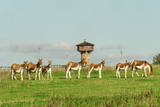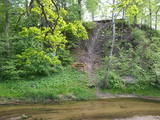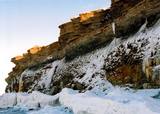| Нo | Название | Описание |
|---|---|---|
|
Dodieties ekskursijā, lai gūtu ieskatu lauku profesijā un dzīvesveidā, kā arī iegūtu jaunus iespaidus un labu atpūtu visai klasei. Ekskursijas laikā apmeklējiet ekopoligonu, kas ir unikāls piemērs ekoloģiski saderīgu darbības virzienu ieviešanai. Pēc tam apmeklējiet saimniecību, kurā iespējams aplūkot Latvijas tumšgalves aitas, uzzināt par to audzēšanas specifiku, dzīves paradumiem un aitkopības nozari Latvijā, kā arī iespējams aplūkot dažādus putnus - tītarus, zosis, pīles, vistas un pērļu vistas. Saimniecībā atrodas arī observatorija, kur var noklausīties lekciju par zvaigznēm, planētām un citām tēmām. Ekskursijas noslēgumā dodieties uz kokapstrādes darbnīcu, lai meistaru vadībā darbotos ar tradicionālajiem kokapstrādes instrumentiem un apgūtu senās spēles. |
||
|
Te plašos aplokos mīt 38 sugu savvaļas dzīvnieki (kiangi, lāči, lūši, vilki, meža cūkas, aļņi, vāveres, plēsīgie putni) un visdažādāko šķirņu mājdzīvnieki – Latvijas zilās, Hailandes un Galovejas govis, Romanovas aitas, Vjetnamas cūkas, pīles, zosis, tītari u.c. Acīgākie dīķos pamanīs retās Eiropas kokvardes. Kalvenes pagasta „Cīruļi” – tā ir lieliska, nesteidzīga atpūta lauku vidē, iepazīstot dzīvo dabu! Darba laiks no novembra līdz martam: katru dienu no 10:00 – 16:00 |
||
|
The Vilce Nature Park is small in size and exists alongside the deep valleys of the Vilce River and its tributaries. Biotopes include visible sandstone cliffs, rapids on the rivers, forests typical of such areas, and the plants and animals that are found therein. The well-appointed Vilce castle hill is next to the Zaķu meadow, which is a nicely appointed and popular place for recreation. |
||
|
Alūksnes novada saimniecībā "Pauguri" kokamatnieks Jānis Vīksne izgatavo koka virpojumus - cibiņas, pulksteņus, pildspalvas, spēles, šūpoles un citas saimniecībā noderīgas lietas. Iespējams iegādāties kokamatniecības suvenīrus - dekoratīvus un praktiskus virpojumus no koka. Senlietu muzeja apskate - seni galdniecības darba galdi, ēveles, āmuri, sirpji, grābekļi, sējmašīna, pulksteņi, trauki u.c. Saimniecībā ir izveidota skatu platforma, no kuras paveras skats uz Hānjas augstienes ainavām Igaunijā, kā arī atpūtas vieta vasaras piknikam ar galdu, uguskura vietu un skulptūrām. |
||
|
В исторических хрониках Кемери (Kemmer) впервые упоминается в 1561 году. Со второй половины XVIII и начала XIX вв. хорошо известны целебные свойства Кемерских серных источников и грязей местных болот, поэтому сюда на лечение отправляются представители Курземских высших кругов. Гостей принимают местные лесники. В это время происходят первые грязевые купания. Развитие юрмальских и кемерских купальней на какой-то момент приостанавливает Отечественная война 1812 года. Два десятилетия спустя, с 1833 по 1835 год, пользу от процедур испытал генеральный губернатор Балтии граф K. M. Пален, который обратился к российскому царю Николаю I за поддержкой для дальнейшего развития курорта. Просьба была удовлетворена, и в 1836 году царь отпускает 700 га государственной земли и предоставляет 100 000 рублей на строительство лечебницы и мощение дороги от Кемери до большака Слока - Тукумс. Два года спустя (1938 г.) открывается первое государственное купальное учреждение. Эта дата считается годом основания курорта. Слава о курорте распространяется во всей Российской империи, и курорт становится все популярнее. В несколько этапов формируется Кемерский ландшафтный парк, являющийся важной составляющей курорта. В середине и во второй половине XIX в. дальнейшему развитию курорта способствуют как движение пароходов, так и движение по железной дороге, открытой в 1877 году от Риги до Тукумса. В 1912 году открывается прямая железнодорожная линия Кемери - Москва. Незадолго до Первой мировой войны количество пациентов в год достигает 8300 человек. Линия фронта Первой мировой войны держится в болоте Кемери несколько лет, и курорт основательно разрушается. Невзирая на это, после войны происходит быстрый подъем, и Кемери становится любимым местом отдыха жителей Риги и одной из самых модных Европейских здравниц. В 1924 году в Кемери строят новое купальное учреждение с грязевыми ваннами, которое на тот момент является одним из современнейших в Европе, а в 1936 году Президент Государства Карлис Улманис открывает одно из выдающихся зданий времен Первой независимой Латвии – гостиницу «Кемери». После Второй мировой войны, в советское время, курорт значительно расширяется, и в его окрестностях открываются почти 10 санаториев, в которых работают около 100 врачей. В 1971 году Кемери присваивается статус курорта Всесоюзного значения. С 1975 по 1985 гг. в Кемери создается крупнейший из санаториев – «Лива» (первоначально – «Латвия»), имеющий два 11-этажных корпуса. В «Ливе» одновременно могли проходить лечение до 1200 пациентов, а в течение года - до 140 000 пациентов. В начале девяностых годов XX столетия санаторий закрыли как нерентабельный. Вплоть до 1994 года в Кемери действуют пять санаториев: «Чайка», «Даугава», «Дзимтене» (Родина), «Кемери» и «Лива» (Латвия) и курортная поликлиника «Кемери». Более позднее время можно рассматривать как своего рода закат Кемери в качестве крупномасштабного лечебного курорта. |
||
|
Кафе находится в центре Тукумса. Латышская кухня: Вареный язык, салат из языков, домашний рассол, салат из тресковой печени, супы (с фрикадельками, фасолевый, щавелевый), тушеные грибы, домашние котлеты, тонкие блинчики, хрустящие овсяные хлопья, клубничный суп. |
||
|
In 1951, when it died, the pine tree had a circumference of 4.63 metres. It was the thickest pine tree in the Baltic States
This is one of the few trees with such a long history for which age has been determined by counting up circles – 370 years. All that’s left is a conserved part of the stump at the side of the road. Cross-sections of the stump are on exhibit at the Latvian Museum of Nature and the Latvian Ethnographic Open-Air Museum.
|
||
|
Ботанический сад был основан в 1923 г. в качестве ботанического научного центра республиканского значения. Сад занимает более 60 га, а для свободного посещения открыты экспозиции общей площадью около 30 га. |
||
|
Auces novads miniatūrā izveidots ar Auces novada nozīmīgākajiem un atpazīstamākajiem objektiem miniatūrā, kuri apdzīvoti ar mājdzīvniekiem. Iespēja Auces novada iedzīvotājiem un viesiem izveidot saikni ar dabu un vienlaicīgi iepazīt Auces novadu. Mazajiem apmeklētājiem izglītojoša saikne ar dzīvniekiem, iespēja tos pabarot ar saimnieku sarūpētajām veltēm. Veicināta Auces novada atpazīstamība caur miniatūriem objektiem. Tiek piedāvāta ekskursija, kuras laikā iespējams apskatīt 4 saimniecības: Zemnieku saimniecību ‘’Skabargas”, Lauku sētu ‘’Krastiņos’’, saimniecību ‘’Andulaiši’ un Lauku sētu ‘’Baltiņi’’. Ekskursija notiek gida pavadībā. Tiek gaidīti viesi, grupās no 10 cilvēkiem, ar iepriekšēju pieteikšanos. |
||
|
Iespaidīgs pilskalns ar izveidotu apskates taku. Blakus ūdenstūristu apmetne „Kvēpene”.
|
||
|
Маршрут предусмотрен для путешественников, которых привлекает большой и частый перепад рельефа, а также для тех, кто жаждет увидеть и на себе испытать впечатляющие берега глубокой древней долины Аматы, передвигаясь по мало тронутым лесным тропам. Тропа, проложенная на правом берегу реки, петляет как по нижней, так и по верхней части долины, поэтому местами необходимо преодолевать перепад высоты более чем 40 метров. Maršruta informācija no Latvijas Lauku foruma |
||
|
Расположено в центре Вентспилса рядом с Ратушной площадью. В приятной атмосфере можно насладиться традиционными блюдами латышской кухни. |
||
|
Баня и место для отдыха «Раудини» - это место, где можно отдохнуть в уютной и тихой атмосфере между морем и лесом. Сможете получить максимальное удовольствие от настоящей дровяной бани, попариться вениками, насладиться полным банным ритуалом с травяным чаем. После парки освежитесь в пруду с кувшинками, и после бани, для полной релаксации, предлагаем шоколадный или медовый массаж. Здесь можно отдохнуть с семьей и в небольшой компании друзьей, приготовить вкусную еду на террасе в настоящей дровяной печи или в камине. Вечером понаблюдать за отблесками заходящего солнца на верхушках деревьев. Для ночлега можно воспользоваться палаточными местами и встретить у моря восход солнца. Тишина, умиротворение и природная свежесть. |
||
|
Die mächtigste Steilküste im Baltikum (bis zu 24 m hoch). In den kalten Winter werden hier phantastische Gletscherstürze entstanden. Pakri Leuchtturm. |
||
|
Город ветра, янтаря и музыкантов. В письменных источниках Лиепая впервые упоминается в 1253 году. Расцвет города как торгового порта начался уже в конце XVI века. Особенно знаменательным было правление Курземского герцога Екаба и Фридриха Казимира, когда через Лиепайский порт обеспечивался экспорт и импорт товаров из Литвы и Курземе. На месте засыпанной песком дюны реки Ливы был прорыт канал, создана пристань для кораблей. Рост города продолжался и в XVIII веке, после Северной войны и эпидемии чумы. Когда в 1795 году Курземе присоединили к Российской империи, Лиепайский порт стал одним из важнейших стремительно развивающихся западных портов империи. В конце XVIII – XIX вв. Лиепая одновременно становится излюбленным местом отдыха аристократии Санкт-Петербурга. В конце XIX века начались работы по возведению крепости и строительству военного порта. Город приобрел военно-стратегическое значение. Лиепая сильно пострадала во время Второй мировой войны. В 1967 году в Лиепае приостановил работу морской торговый порт, и город стал закрытым городом, где военный порт стал городом в городе. Сегодня военный порт и связанное с ним предложение является одним из востребованных продуктов туризма Латвии. |
||
|
Saimniecība "Dižgāļi" Alsungā nodarbojas ar bioloģisko lauksaimniecību, gaļas liellopu audzēšanu un aitu audzēšanu. Apmeklētājiem ir iespēja aplūkot saimniecību, tajā esošos dzīvniekus, kā arī iegādāties svaigo produkciju. Saimniece pastāstīs par vietas vēsturi, kā arī pacienās viesus ar vistas zupu. |
||
|
The classical skyline of Old Rīga can be enjoyed from several locations – Mūkusalas Street, between the railroad bridge and the stone bridge, from the stone bridge, from the A-B dam, from the grounds of the central office of the Swedbank bank, from the Vanšu bridge, and from the Ballast Dam at Ķīpsala. You can hike or bike from location to location. During the summer, little ships cruise up and down the Daugava to offer different views.
|
||
|
Маршрут проходит через Национальный парк Гауя, который расположен на двух берегах древней долины реки Гауя. Обрывы из песчаника и пещеры, холмистый ландшафт и дремучие леса, а также замки — это неотъемлемая характеристика парка. Позже,в поместье Игате, остановитесь на обед в их таверне, расположенной на мельнице, и отведайте традиционную латвийскую кухню. Затем маршрут поворачивает к побережью, принадлежащему Резервату Биосферы Северного Видземе, и продолжается вдоль старых эстонских рыбацких деревень, прежде чем доходит до морского курорта Пярну с его элегантными виллами. Затем вас ждет день на природе в Национальном парке Соомаа под руководством гида, где вы сможете прогуляться по болоту в специальной старомодной обуви и поплавать на байдарках. А далее по маршруту вы проедете мимо Поотси с его поместьем 19 века и старинную деревню Варбла. Переедьте на пароме на остров Муху и остановитесь в этнографической рыбацкой деревне Когува на пару дней, для того, чтобы ознакомиться с местностью. Затем отправьтесь на велосипеде вдоль дамбы на остров Сааремаа, откуда вы сможете на пароме переправиться на спокойный остров Хиумаа и провести там день в атмосфере истинно эстонского духа. А по возвращении на Сааремаа, вас ждет свободный день для знакомства со столицей острова Курессааре, с его многообразием спа и релаксационных заведений. Затем на автобусе держите путь на Таллинн, очаровательный город с его средневековым Старым Городом. Оттуда направляйтесь на день на бывшую военную базу на острове Найссаар, где специальные маршруты для велосипедистов знакомят с его военной историей, рудником и природными резерватами. |
||
|
Сыроварня в Рауне – это предприятие семьи Цериньшев, которое уже 10 лет предлагает покупателям 23 наименования высококачественных продуктов – сыры, сливочное масло и макароны. Самым излюбленным продуктом, изготавливаемым на предприятии, стал «Зеленый сыр», один из ингридиентов которого – пажитник голубой – выращивается в собственном саду. Пажитник – это однолетнее растение со светло-фиолетовыми цветами. Пока новые побеги мягкие, их срывают и сушат в сушилке, отапливаемой дровами. После высушивания пажитник размалывают, просеивают и добавляют в белковую массу, которую тонким слоем помещают в деревяные ящики особого изготовления и сушат. После добавления пажитника продукт получает характерный вкус, цвет и запах «Зеленого сыра». По предварительной договоренности группам численностью более 10 человек предоставляется возможность осмотреть предприятие и ознакомиться с процессом производства продукции. |
||
|
A bit less than one kilometre from the Aizkraukle castle hill, the church can be seen from the Rīga-Daugavpils highway (A6). The church was built in 1688 on the steep banks of the
|
||

























